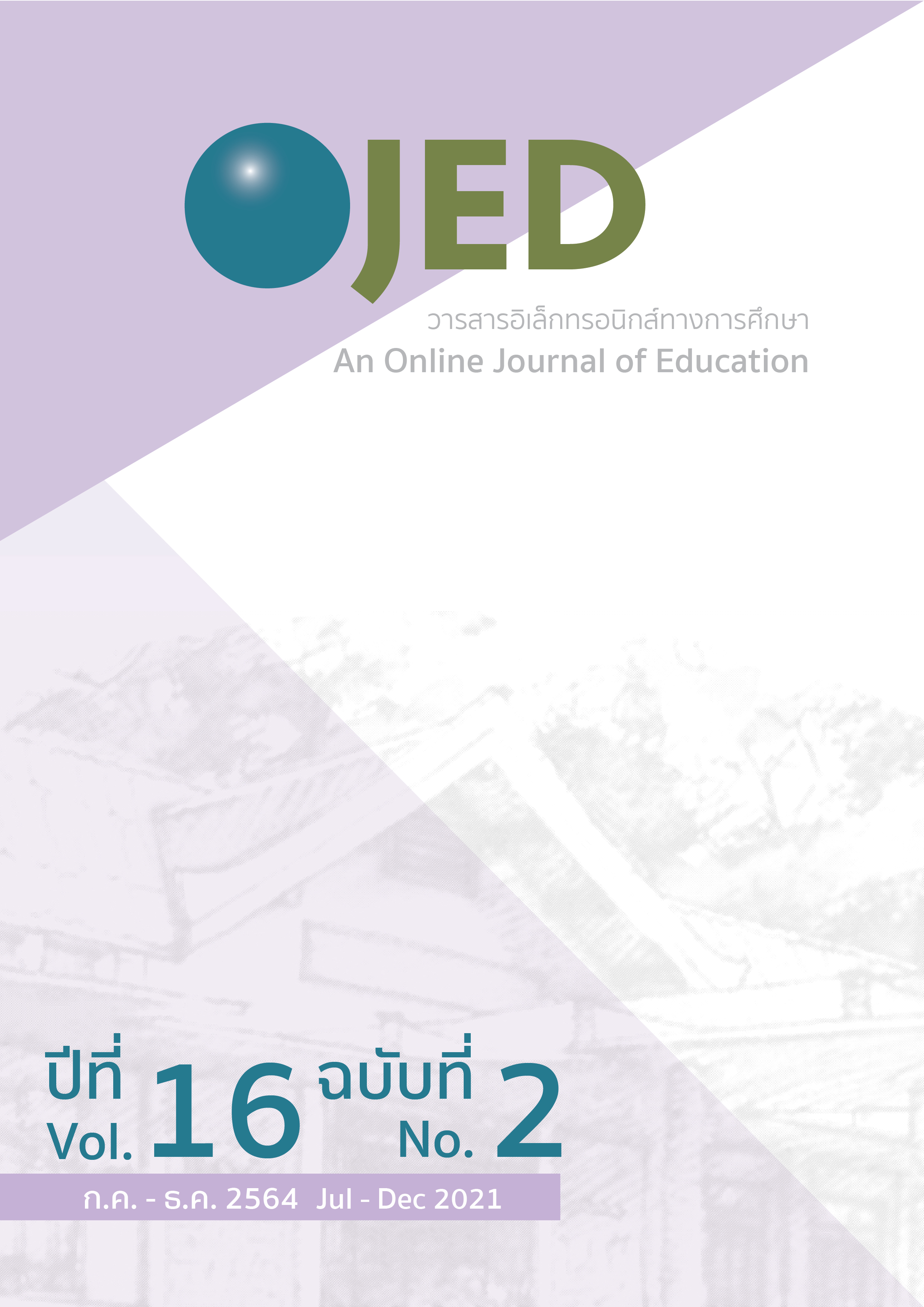Analysis of Teacher’s English Teaching Practices to Preschoolers in School Under The Office of The Private Education Commission, Mueang Nonthaburi District, Nonthaburi Province
DOI:
https://doi.org/10.14456/ojed.2021.40Keywords:
teacher’s practices, English teaching, kindergarten studentsAbstract
The purpose of this research was to study teacher’s English teaching practices to preschoolers in 3 aspects: 1) organizing learning experiences 2) arranging learning environment and learning atmosphere and 3) coordinating with parents. The population were of 86 early childhood homeroom teachers in school under The Office of The Private Education Commission, Mueang Nonthaburi District, Nonthaburi Province, Academic year 2020. The research instrument was questionnaire. The data were analyzed using frequency, percentage, average, standard deviation and content analysis. The research finding found that the overall of teacher’s English teaching practices to preschoolers were at high level performance (m=4.12). The highest score was learning experiences organization (m=4.32), setting up the learning environment and atmosphere (m=4.21) and coordinating with parents (m=3.83)
References
ชลดา รักแจ้ง, จิตติรัตน์ แสงเลิศอุทัย, และ รัฐดาว พิศาลพงษ์. (2556). การพัฒนาชุดกิจกรรมภาษาอังกฤษเพื่อส่งเสริมทักษะการฟังภาษาอังกฤษสำหรับเด็กปฐมวัย. [วิทยานิพนธ์ปริญญามหาบัณฑิต]. NPRU – Online Journal and Research Databases. https://publication.npru.ac.th/handle/123456789/675
ธัญวรัตน์ โหสุภา. (2559). ผลของการจัดประสบการณ์โดยบูรณาการแนวการสอนแบบเน้นงานปฏิบัติที่มีต่อความเข้าใจคำศัพท์ภาษาอังกฤษของเด็กอนุบาลในโรงเรียนสังกัดสำนักการศึกษากรุงเทพมหานคร [วิทยานิพนธ์ปริญญามหาบัณฑิต]. Chulalongkorn University Intellectual Repository (CUIR). http://cuir.car.chula.ac.th/bitstream/123456789/55426/1/5683341627.pdf
บริติช เคานซิล. (2021). เตรียมความพร้อมสำหรับศตวรรษที่ 21 ด้วยการเรียนภาษาอังกฤษตั้งแต่เด็ก. https://www.britishcouncil.or.th/english/learningtimewithtimmy/tips/how-to-prepare-your-child-for-21st-century
วรนาท รักสกุลไทย. (2554). สุดยอดเทคนิคการจัดการเรียนรู้แบบครูมืออาชีพ. แฮปปี้ เลิร์นนิ่ง.
วรนาท รักสกุลไทย และ นฤมล เนียมหอม (2552). การจัดประสบการณ์เพื่อพัฒนาเด็กปฐมวัยด้านภาษา. ใน ประมวลสาระชุดวิชาการจัดประสบการณ์สำหรับเด็กปฐมวัย (น. 10-1 - 10-50). สาขาวิชาศึกษาศาสตร์ มหาวิทยาลัยสุโขทัยธรรมาธิราช.
ศรีนวล ฟองมณี. (2560). การพัฒนาสื่อประสมวิชาภาษาอังกฤษระดับปฐมวัย สำหรับโรงเรียนขนาดเล็กในเขตพื้นที่ตำบลเวียงชัย. วารสารการวิจัยกาสะลองคำ, 11(3), 145-155.
สมโภชน์ พนาวาส. (2556). การศึกษาสภาพปัญหา ความต้องการ และแนวทางการจัดประสบการณ์การเรียนรู้ภาษาอังกฤษสำหรับเด็กปฐมวัย (รายงานผลการวิจัย). คณะมนุษย์ศาสตร์และสังคมศาสตร์มหาวิทยาลัยราชภัฏสวนดุสิต.
สำนักงานคณะกรรมการการศึกษาแห่งชาติ. (2544). การพัฒนาเครือข่ายการจัดการศึกษาโดยครอบครัวในสังคมไทย. พิมพ์ดี.
สำนักงานคณะกรรมการส่งเสริมการศึกษาเอกชน. (2564). แผนปฏิบัติราชการประจำปีงบประมาณ พ.ศ. 2564. https://bit.ly/3ub9ZVC
สำนักงานเลขาธิการสภาการศึกษา. (2552). สมรรถนะของเด็กปฐมวัยในการพัฒนาตามวัย 3-5ปี แนวสำหรับผู้ดูแลเด็กครูและอาจารย์. บริษัท แปลนฟอร์คิดส์ จำกัด.
Barberá, G. 1995. (coor.): Oposiciones al Cuerpo de Maestros: Inglés. Madrid, Escuela Española.
Cerná, M. (2015). Pre-primary English in the Czech Republic. In S. Mourao & M. Lourenço (Eds.), Early years second language education (pp. 165-176). Routledge.
Dunsmore, L. (2018, October 26). 10 Tips When Teaching English as a Foreign Language to Children. International TEFL and TESOL Training. https://www.teflcourse.net/blog/10-tips-when-teaching-english-as-a-foreign-language-to-children-ittt-tefl-blog/
Esteve, P. P. (1999). «¿Cómo abordar la lengua extranjera en educación infantil y primer ciclo de educación primaria?», Aula de Innovación Educativa, Marzo, 80, 77-82. https://dialnet.unirioja.es/servlet/articulo?codigo=168070
Ford, K. (2019). Language Development for Preschool ELLs (5 Classroom Strategies: Language). https://www.colorincolorado.org/article/8-strategies-preschool-ells-language-and-literacy-development/
López, B. R. & Méndez, R. V. (2004). Models of Teaching Foreign Languages to Young Children. Didáctica (lengua y literatura), 16, 163-175. https://www.researchgate.net/publication/27576030_Models_of_Teaching_Foreign_Languages_to_Young_Children
Mourão, S. (2019). Integrating and emulating: Early English initiatives in Portugal. In J. Rokita-Jaśkow & M. Ellis (Eds.), Early instructed second language acquisition:Psycholinguistic and sociocultural aspects. Multilingual Matters.
Murphy, V. A., Evangelou, M., Goff, J., & Tracz, R. (2016). European perspectives on early childhood and care in English for speakers of other languages. In V. A. Murphy & M. Evangelou (Eds.), Early childhood education in English for speakers of other languages, 57-74.
Robertson, N., Morrissey, A. M., & Rouse, E. (2018). Play-based learning can set your child up for success at school and beyond. Science Education News, 67(1), 50–51. https://search.informit.org/doi/10.3316/informit.499375020726481
Downloads
Published
How to Cite
Issue
Section
License
Copyright (c) 2021 An Online Journal of Education

This work is licensed under a Creative Commons Attribution-NonCommercial-NoDerivatives 4.0 International License.




